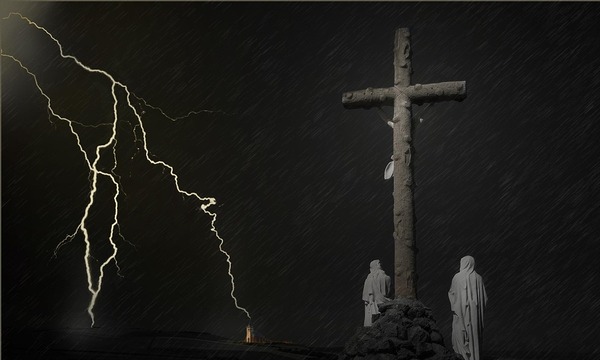My recent book on Old Testament theology was an experiment in co-authoring. While articles in the sciences almost always have multiple authors, in my field of biblical studies co-authoring is rare. Partly this is due to the nature of the field, as science articles require the expertise of many different specialists. The closest parallel to this in biblical studies is archaeology, where site reports include many different authors from a variety of disciplines. However, in biblical studies scholars are generally expected to master all the relevant areas themselves. In this post I want to address why I wanted to co-author the book, talk about some of the specific mechanics of doing so, and reflect on the experience through the form of an interview.
Who came up with the idea of co-authoring?
Charlie: When I started working on the basic outline of this project, I quickly realized that I was facing an overwhelming number of books to read. I was also nervous about surveying such a complicated field by myself. For those two reasons, I decided that it would be best to find a co-author.
How did you decide on a co-author?
Charlie: In my case, this was relatively simple. Brittany Kim and I were in the Ph.D. program at Wheaton College together and co-authored an article several years ago on YHWH as a dragon. For that article, I had asked her to join me because of her expertise in metaphor: I was interested in the metaphor of YHWH breathing fire, but I didn’t know enough about metaphor theory. Her contribution to that project was essential, and I learned a lot about metaphors myself. Since I knew from experience that Brittany was a great writer and that we worked well together, it was an obvious choice to ask her to join the project.
How did it feel to join a project that was not your idea?
Brittany: I have a strong interest in Old Testament theology and clearly saw the need for a book to survey the field, so it was easy for me to become personally invested in the project. I think it would have been more difficult if Charlie had had a firm conception of what he wanted the book to look like without giving me meaningful input into it. But although he had an initial outline when he first contacted me, that shifted significantly as we shaped the book together.
How did the initial stages work?
Charlie: As Brittany noted, I had already created an initial outline for the book, but when she joined the project, she offered many helpful suggestions. After we had what we thought was a relatively stable outline, we divided the chapters equally between us. However, in retrospect it turned out that the outline remained in constant flux throughout the entire project, and the relative number of chapters we each wrote kept on shifting. We also sought input from each other on many matters related to planning the book, such as deciding which chapter a source would go in and what the main points of each chapter would be. When it came to writing documents related to the book, such as the proposal and advertising summaries, we split the work by writing style: I tend to get ideas on paper quickly but not in a carefully crafted form, so I often created a rough draft of whatever document was needed. Then Brittany went through it with a detailed eye to edit and expand it as needed. However, when it came to the book itself, we each wrote our own chapters independently.
What are some of the technical details about co-authoring?
Charlie and Brittany: Since we live in different states, we were only able to meet one time in person to work on editing together. Therefore, the vast majority of our editing was done long distance. We generally wrote in Google Docs for documents like the proposal, the outline, and the annotated bibliography so that we could easily see each other’s work. When we both signed off on the document, we would then convert the document to a Word document and submit it. For the manuscript, however, we wrote in Microsoft Word and saved it in a shared Dropbox folder. This is not as seamless as Google Docs because changes made by one person are not seen by the other person in real time. But the features of Microsoft Word are so much better that this was the best way forward for us. For smaller-scale edits we used the track changes feature, and for more substantial edits we used the comment feature. Toward the end of the process, we spent a significant amount of time on the phone discussing various levels of editing.
How did the editing process work?
Brittany: We read each other’s work multiple times, and I did a substantial amount of re-writing in response to both Charlie’s feedback and our shifting outline. After we finished writing, we did a stylistic edit to make the voice more consistent and catch errors and awkward sentences. In general, I’m more nitpicky, so I did more line editing. But we both had particular stylistic preferences that came out during this process. For example, I tried to tone down Charlie’s generous use of parentheses, and Charlie asked me to reword all my “there is/are” statements.
Any recommendations you have for others who are thinking about co-authoring?
Charlie: I think it’s probably best to work on a smaller project together before starting a book: it will reveal areas that might perhaps cause significant problems in a larger project. I would also recommend working with people that you like spending some time with: if you dread meeting with your co-author then that’s a recipe for failure! Choosing someone with similar views would be important for a coherent voice, but it’s also good to write with someone who’s not exactly like you for the sake of challenging your thinking. Relying on the expertise of co-authors also offers an important reminder for those of us in academia who are often tempted to view ourselves as imposters if we’re not masters of everything in our field. While I could see some co-authoring situations becoming torturous, in our case it was a wonderful experience. I now encourage my fellow scholars to co-author books and articles as much as they can!
Brittany: Not only does co-authoring allow you to produce something that you may not have the time, energy, or knowledge base to write by yourself, but it also makes your writing less isolating and more communal. Having a co-author to provide moral support, help in brainstorming when you get stuck, and give crucial feedback on your work can make the process of writing less overwhelming and improve the final product. It’s important to develop a sense of trust in the working relationship so that you can receive feedback from each other well. And keeping open communication throughout the process is key, especially concerning each author’s non-negotiables and areas where you may need to compromise. It’s also worth considering the power dynamics of the working relationship, especially when a professor writes with a graduate student. In our case, we approached the project as equals, but differences in race, gender and/or stage of career could create power differentials that need to be addressed at the beginning of the project.
 Biola University
Biola University



.jpg)
